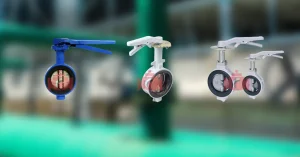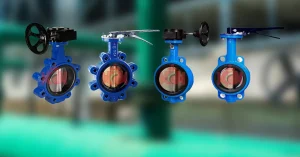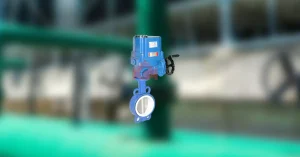Table of Contents
Manual Butterfly Valves vs. Pneumatic Butterfly Valves: Pros, Cons & Use Cases
Butterfly valves may not be the flashiest piece of equipment in a system, but they are certainly one of the most essential. With their simple yet efficient design, butterfly valves are widely used to regulate or isolate the flow of fluids across industries like oil and gas, chemical processing, water treatment, and HVAC systems.
When it comes to control mechanisms for butterfly valves, two popular choices are manual butterfly valves and pneumatic butterfly valves, each with its own unique set of features, benefits, and drawbacks. We will explore breaks down the differences between these two types, helps you understand their uses in real-world applications, and provides recommendations to guide your selection process.
What Is a Butterfly Valve?
A butterfly valve is a quarter-turn rotational valve that uses a disc-like mechanism to regulate the flow of fluids through a pipeline. The valve’s disc rotates around an axis (much like a butterfly wing, which inspired its name) to fully open, partially open, or shut off the flow of a medium.
Butterfly valves are lightweight, compact, and suitable for handling large volumes of liquids, gases, or slurries. From managing water distribution to controlling pressurized gases in a chemical environment, butterfly valves offer critical functionality in many industrial and commercial processes.
Manual Butterfly Valves
How Do Manual Butterfly Valves Work?
Manual butterfly valves rely on physical force to operate. They feature a handwheel, lever, or gear mechanism that allows an operator to manually open, close, or adjust the valve position.
Pros of Manual Butterfly Valves
- Simplicity: Manual butterfly valves are straightforward in design, with minimal mechanical components. This simplicity ensures reliable performance and reduces the likelihood of operational issues.
- Low Cost: These valves are significantly more affordable than their pneumatic counterparts due to their manual operation and lack of automation hardware.
- Ease of Maintenance: With fewer moving parts, manual valves are easier to repair and require less upkeep.
Cons of Manual Butterfly Valves
- Slower Operation: Adjusting a manual valve requires more time and effort, which might not be ideal for critical processes that demand precise, quick flow adjustments.
- Not Suitable for Automation: Since manual valves lack the ability to connect to remote control systems or automation processes, they are less versatile in modern, tech-driven setups.
Use Cases for Manual Butterfly Valves
- Water treatment plants for simple flow control.
- Irrigation systems in agriculture.
- Industrial applications where automation is unnecessary or cost-prohibitive.
Pneumatic Butterfly Valves
How Do Pneumatic Butterfly Valves Work?
Pneumatic butterfly valves use compressed air to operate. These valves integrate an actuator that converts the energy of compressed air into mechanical motion to open or close the valve disc. They can be controlled either remotely or automatically, often as part of a larger process automation system.
Pros of Pneumatic Butterfly Valves
- Faster Operation: Pneumatic actuators offer rapid opening and closing speeds, drastically improving response timing compared to manual systems.
- Automation-Friendly: These valves are compatible with PLCs (Programmable Logic Controllers) or other central control systems, enabling seamless automation and remote adjustments.
- Precision and Scalability: Pneumatic systems can handle complex processes requiring precise flow adjustments, benefiting large-scale industrial applications.
Cons of Pneumatic Butterfly Valves
- Higher Cost: The inclusion of a pneumatic actuator, tubing, and other components means these valves are more expensive than manual options.
- Requires a Compressed Air System: To function properly, pneumatic valves need access to a reliable compressed air system, which adds to overhead maintenance costs.
- Complex Maintenance Requirements: Pneumatic components (like actuators and air supply systems) require regular monitoring and technical expertise for smooth operation.
Use Cases for Pneumatic Butterfly Valves
- Chemical processing facilities that require automated flow control.
- Oil and gas pipelines where remote valve control is essential.
- High-speed production lines in manufacturing and packaging industries.
Manual Butterfly Valves vs. Pneumatic Butterfly Valves: A Quick Comparison
| Feature | Manual Butterfly Valves | Pneumatic Butterfly Valves |
| Operation | Hand-operated | Actuator-driven (compressed air) |
| Cost | Low | High |
| Speed | Slower | Faster |
| Automation Capability | None | High (supports remote/automatic control) |
| Maintenance Complexity | Simple | Moderate to complex |
| Best For | Basic systems, low budget | Automated setups, high precision needs |
Factors to Consider When Choosing Manual Butterfly Valves vs. Pneumatic Butterfly Valves
1. Budget: Manual butterfly valves are more cost-effective upfront, making them ideal for operations with limited budgets. Pneumatic valves, however, can offer long-term savings in labor and efficiency for businesses willing to invest.
2. Level of Automation: If your system requires remote or automated control, pneumatic valves are the clear winner. For setups where hands-on control is sufficient, manual valves do the job perfectly.
3. Operational Speed: Time-sensitive processes often demand the speed and efficiency of pneumatic valves. Manual valves, while reliable, may prove too slow for such applications.
4. Maintenance Capabilities: For teams with limited technical expertise or resources, manual valves are easier to maintain and more straightforward to operate. Pneumatic valves, on the other hand, need skilled technicians for troubleshooting and upkeep.
5. Environment and Industry: Your specific environment and industry will heavily influence your decision. For example:
- Industries with hazardous conditions requiring hands-off operation benefit from pneumatic valves.
- Simpler industries like water pumping or irrigation often find manual valves sufficient.
Where to Source Your Butterfly Valves
Whether you’re looking for robust manual butterfly valves or state-of-the-art pneumatic butterfly valves, Concorde Valves and Automations has you covered. With a commitment to quality and innovative solutions, Concorde Valves is a trusted name in the field of flow control systems.
Making the Right Choice
Selecting the right butterfly valve for your application hinges on understanding your needs and priorities. Manual butterfly valves are simple, affordable, and dependable for basic systems, while pneumatic butterfly valves offer speed, precision, and automation for complex, large-scale operations.
When in doubt, consult an expert. At Concorde Valves and Automations, our specialists can guide you to the perfect solution based on your unique requirements.
When efficiency matters, choose wisely.
Manual Butterfly Valves vs. Pneumatic Butterfly Valves

Discover the key differences between Manual Butterfly Valves and Pneumatic Butterfly Valves, including their advantages, disadvantages, and practical applications. This comprehensive guide will help you choose the right valve type to enhance efficiency, reliability, and performance in your specific operations.
Product Brand: Concorde Valves and Automations
Product Currency: INR
Product In-Stock: InStock
5




